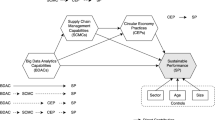Abstract
It is a matter of common knowledge that the trucking industry has an important role in strengthening national competitiveness. Recently, in most countries, the trucking industry has faced the task of enhancing its efficiency. To achieve this, a detailed and objective assessment method for the efficiency of current trucking companies is required. This study suggests a network Data Envelopment Analysis (DEA) model for evaluating the efficiency of the trucking industry in Korea. The model was formulated by combining a network DEA model with a modified version of the Banker, Charnes, and Cooper (BCC) model. The proposed model can evaluate the management efficiency of the trucking industry by considering operation and profitability efficiencies sequentially. The model also considers both desirable and undesirable outputs, so it provides more information that can be used to evaluate the efficiency of the trucking industry than dose the traditional DEA model. The Korean trucking industry’s efficiency was analyzed using the model developed in this study. The results show that the large truck companies that use trucks of maximum loading capacities that exceed five tons have the highest efficiency and that the factors that have significant influence on efficiency are service performance, the number of transaction steps, and daily labor hours. The proposed model can contribute to the efficiency evaluation of the trucking industry and help the trucking companies direct their efforts more effectively.
Similar content being viewed by others
References
Ali, I. and Seiford, L. M. (1990). “Translation invariance in data envelopment analysis.” Operational Research Letters, Vol. 9, No. 6, pp. 403–405.
Chang, M. H. (2010). “Relative efficiency of Korea trucking transport business using DEA model.” The Journal of the Korea Contents Association, Vol. 10, No. 12, pp. 328–341.
Farrell, M. J. (1957). “The measurement of productivity efficiency.” Journal of the Royal Statistical Society, Series A, General, Vol. 120, No. 3, pp. 253–281.
Färe, R. and Grosskopf, S. (2000). “Network DEA.” Socio-Economic Planning Science, Vol. 34, No. 1, pp. 35–49.
Färe, R., Grosskopf, S., and Knox Lovell, C. A. (1985). The measurement of efficiency of production, Kluwer-Nijhoff, Boston, MA.
Färe, R., Grosskopf, S., and Whittaker, G. (2007). Network DEA, Zhu J, Cook WD. (Eds.). Modeling data irregularities and structural complexities in data envelopment analysis, Springer Science Series (Chapter 12).
Ha, H. G. and Choe, A. Y. (2007). “Analysis of the efficiency of Korea’s logistics industry: Application of data envelopment analysis-analytic network process.” Journal of Korean Society of Transportation, Vol. 25, No. 3, pp. 55–63.
Ha, H. K., Lee, S. W., and Cheng, Z. (2006). “Analyzing the productivity of Korea and China’s road freight transport industry: A nonparametric Malmquist approach.” Journal of International Logistics and Trade, Vol. 4, No. 2, pp. 1–12.
Hahn, J. S., Kim, H. R., and Kho, S. (2011). “Analysis of the efficiency of seoul arterial bus routes and its determinant factors.” KSCE Journal of Civil Engineering, Vol. 15, No. 6, pp. 1115–1123.
Han, S. Y. (2010). “Productivity evaluation and factor analysis in commercial road freight transport industry.” Journal of Korean Society of Transportation, Vol. 28, No. 5, pp. 31–41.
Hjalmarsson, L. and Odeck, J. (1996). “Efficiency of trucks in road construction and maintenance: An evaluation with data envelopment analysis.” Computers & Operations Research, Vol. 23. No. 4, pp. 393–404.
Kleinsorge, K., Schary, P. B., and Tanner, R. D. (1992). “Data envelopment analysis for monitoring customer-supplier relationships.” Journal of Accounting and Public Policy, Vol. 11, No. 4, pp. 357–372.
Korea Development Institute (2008). A study on standard guidelines for pre-feasibility study on road and railway projects (5th Edition), Korea Development Institute, Korea.
Lim, J. K. (2007). A study on the efficiency of trucking industry in Korea, PhD Thesis, Seoul National University, Korea.
Odeck, J. and Hjalmarsson, L. (1996). “The performance of trucks — an evaluation using data envelopment analysis.” Transportation Planning and Technology, Vol. 20, No. 1, pp. 49–66.
Park, M. S. and Ahn, Y. H. (2003). “Using DEA-AR to measure the efficiency of motor carriers in Korea.” Journal of the Korean Society of Supply Chain Management, Vol. 3, No. 2, pp. 61–68.
Pattanamekar, P., Kim, C. S, Park, D. J., and Lee, K. D. (2011). “Technical efficiency analysis of shippers using DEA.” Journal of Advanced Transportation, Vol. 45, No. 3, pp. 161–172.
Scheraga, A. (2011). “Strategic fit in the general freight motor carrier industry.” Transportation Research Part E, Vol. 47, pp. 490–506.
Seiford, L. M. and Zhu, J. (2002). “Modeling undesirable factors in efficiency evaluation.” European Journal of Operational Research, Vol. 142, No. 1, pp. 16–20.
Sheth, C., Triantis, K., and Teodorovic, D. (2007). “Performance evaluation of bus routes: A provider and passenger perspective.” Transportation Research Part E, Vol. 43, No. 4, pp. 453–478.
Shin, D. S. (1995). “Study on the efficiency of consignment contracts between goods carriers and drivers.” Journal of Transport Research, Vol. 2, No. 3, pp. 51–63.
The Korea Transportation Institute (2011). A freight transportation market trends, Korea Transportation Institute, Korea.
Tone, K. and Tsutsui, M. (2009). “Network DEA: A slacks-based measure approach.” European Journal of Operational Research, Vol. 197, No. 1, pp. 243–252.
Yoon, J. J. and Le, Y. (2013). “Analysis of the transport efficiency of reverse logistics in Japan.” International Journal of Urban Sciences, Vol. 17, No. 3, pp. 399–413.
Author information
Authors and Affiliations
Corresponding author
Rights and permissions
About this article
Cite this article
Hahn, JS., Sung, H.M., Park, M.C. et al. Empirical evaluation on the efficiency of the trucking industry in Korea. KSCE J Civ Eng 19, 1088–1096 (2015). https://doi.org/10.1007/s12205-012-1009-7
Received:
Revised:
Accepted:
Published:
Issue Date:
DOI: https://doi.org/10.1007/s12205-012-1009-7




